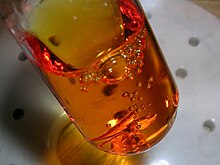Aqua regia
| General | |||||||||||||
|---|---|---|---|---|---|---|---|---|---|---|---|---|---|
| Surname | Aqua regia | ||||||||||||
| other names |
|
||||||||||||
| Molecular formula | cannot be specified because it is a mixture | ||||||||||||
| Brief description |
yellow to red-brown liquid |
||||||||||||
| External identifiers / databases | |||||||||||||
|
|||||||||||||
| properties | |||||||||||||
| Molar mass | cannot be specified because it is a mixture | ||||||||||||
| Physical state |
liquid |
||||||||||||
| solubility |
completely miscible with water |
||||||||||||
| safety instructions | |||||||||||||
|
|||||||||||||
| As far as possible and customary, SI units are used. Unless otherwise noted, the data given apply to standard conditions . | |||||||||||||
Aqua regia , rarely also called regal acid, is a mixture of concentrated (37%) hydrochloric acid and concentrated (65%) nitric acid in a ratio of 3 to 1. It was known to the Persian author Ali Geber as early as the 8th century.
Naming
The name aqua regia ( lat. Aqua regis or aqua regia , royal water ") is derived from the ability of this mixture, the" royal "precious metals gold and platinum to solve. Gold is converted into tetrachloroauric acid , from platinum to platinum (IV) chloride from the hexachloroplatinic acid .
Chemical effect
The ability of aqua regia to dissolve gold can be explained in different ways. The older literature in particular does not make the acids themselves responsible for the aggressiveness of aqua regia, but rather reaction products that arise when the two acids are mixed.
The result is nascent chlorine and nitrosyl chloride (NOCl), which gold and other precious metals such as platinum and palladium are able to oxidize.
An alternative explanation is the complexation of the metal oxidized by nitric acid. The presence of chloride reduces the normal potential (Au / Au 3+ + 3 e - , E 0 = 1.52 V):
Au + 4 Cl - [AuCl 4 ] - + 3 e - , E 0 = 0.93 V. The oxidizing power of nitric acid is then sufficient:
NO 3 - + 4 H + + 3 e - NO ( g ) + 2 H 2 O, E 0 = 0.96 V.
- .
The same effect also occurs when sodium chloride or another chloride is added to nitric acid .
The high concentration of chloride ions increases the solubility of the precious metals, which are dissolved in the form of anionic chloride complexes . Zirconium , hafnium , niobium , tantalum , titanium , ruthenium and tungsten resist the attack of aqua regia at room temperature due to their passivation . Compact silver is not dissolved because it is passivated by the formation of an insoluble silver chloride layer before further attack .
Aqua regia disintegrates by itself, releasing chlorine, nitrosyl chloride and nitrous gases . It is therefore usually freshly prepared from the two acids immediately before use.
Aqua regia as a mixture of nitric acid and hydrochloric acid has the UN number 1798 in dangerous goods law. Its carriage on European roads is prohibited according to the European Convention on the Carriage of Dangerous Goods by Road .
Applications
- With the help of aqua regia, u. a. Manufactured precious metal preparations for porcelain and glass painting .
- In analytical chemistry , aqua regia is used to digest poorly soluble material samples. (see also aqua regia digestion )
- In metallography , aqua regia is used with some alloys to make the crystalline structure of a surface visible.
- In various concentrations it is still used today to check the kar activity (an old term for fineness ) of gold. The solubility of an abrasion sample in the various solutions is tested.
In the past, aqua regia was used externally (in strong dilution):
"In the winter of 1857-58 I had a sick person in my ward who retained anesthesia from frostbite of his feet, whereas I used local baths with aqua regia, among other things."
Historical anecdote
When German troops occupied the Danish capital Copenhagen in April 1940 in the course of the Second World War, the Hungarian chemist George de Hevesy , who worked in Niels Bohr's laboratory, dissolved the golden Nobel Prize medals of the German physicists Max von Laue and James Franck in aqua regia to prevent access by the Nazis. Von Laue and Franck were in opposition to National Socialism in Germany and had therefore entrusted their medals to Niels Bohr in order to prevent confiscation in Germany; The National Socialist government banned all Germans from accepting or wearing the Nobel Prize after the Nazi opponent Carl von Ossietzky had received the Nobel Peace Prize in 1935. After the end of the war, de Hevesy extracted the gold "hidden" in the aqua regia and gave it to the Royal Swedish Academy of Sciences , which made new medals from them and handed them over to von Laue and Franck.
Individual evidence
- ↑ a b c Entry on aqua regia in the GESTIS substance database of the IFA , accessed on January 26, 2013(JavaScript required) .
- ^ Brockhaus ABC Chemie , VEB FA Brockhaus Verlag, Leipzig 1965, p. 714.
- ^ Nobelprize.org .








